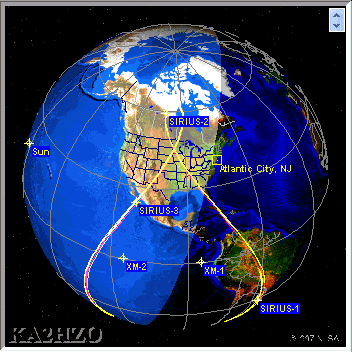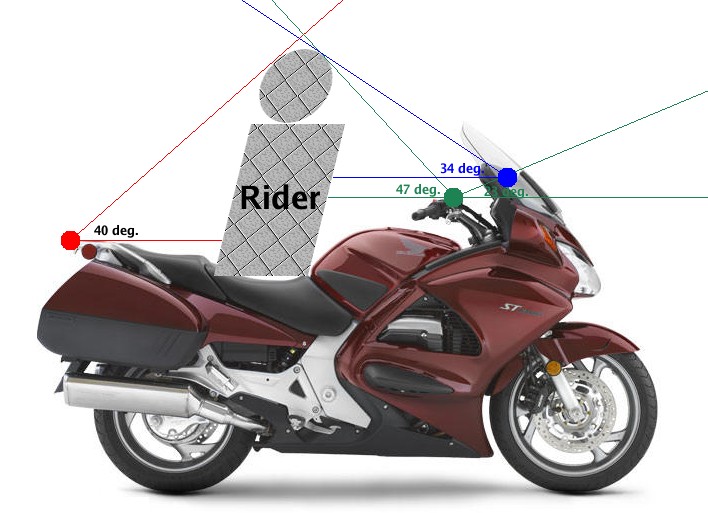You are here: STWiki>General Web>SatelliteAntennaPlacement (21 Sep 2007, MarkFeit)Edit Attach
Selecting a Location for a Satellite Antenna
Background
XM Satellite Radio
XM has three satellites, called Rock, Roll and Rhythm (also known as XM-1, XM-2 and XM-3). It works out that the easiest orbit for a satellite to maintain is called a geosynchronous orbit, which means the satellite spins around the Earth over the equator at the same speed as the Earth rotates. For someone on the ground, that makes the satellite appear "parked" in the same spot. Most communications satellites, including those that carry satellite TV, work that way, and that's why you don't have to go out and re-point your DirecTV antenna before you turn on the TV. Rock and Roll are parked over the equator at longitude 115W, out in the ocean, and Rhythm is parked at 85W, between Ecuador and the Galapagos Islands. That means that for someone in Ecuador, Rhythm is almost directly overhead, an ideal location, because obstructions like terrain, trees, buildings (and you, should you be on a motorcycle) are much less likely to block the signal. The problem with being parked over the equator is that as you get further north, the satellite gets progressively lower in the sky (has a lower angle of elevation), making obstructions a bigger problem. For example, if you live in Brownsville, TX, if you can point yourself at 150 degrees (azimuth) with a compass, tilt your head 56 degrees in the air (elevation) and see sky, you've got line-of-sight to Rhythm and should get a good signal. Go further north to Wichita, you look at 158 degrees azimuth but only 44 degrees of elevation. All the way up at the Canadian Border in North Dakota, the elevation drops to 32. There's a tool to calculate azimuth and elevation here. If you live in the eastern part of the country, look at XM-3; if you live in the west, look at XM-1 or XM-2. XM compensates for the low angle problem by concentrating more of its power on the northern parts of the country (and none in the Galapagos Islands), since those in the south will have an easier time seeing the satellite. (Here's a chart that shows it. Greater numbers mean more power, so -120 is better than -132.) That helps somewhat, but the problem is that for most of the country, the best signals are going to come from the southwest, and if you have obstructions in that direction, you're going to get dropouts and there's nothing you can do about it. In densely-populated areas, XM installs transmitters called repeaters to make sure there's a good signal available if there are significant terrain problems or the canyons you find in the city. Your receiver will automatically use the strongest signal it can find (which will be one of Rock, Roll, Rhythm and a repeater if one is available). The satellites will be at one of two angles, so sometimes if one is blocked, the other might be visible and that one will be used.Sirius Satellite Radio
Like XM, Sirius also has three satellites called Radiosat 1, Radiosat 2 and Radiosat 3. (There is already a set of satellites named Sirius that is operated by SES Sirius of Sweden.) They also own a fourth, which waits ready for launch should one of the orbiting units fail. Unlike XM, these satellites are in what's called an inclined elliptical geosynchronous orbit. In layman's terms, this means the orbit is at an angle relative to the equator and isn't round like the Earth's, it's an ellipse that makes it dwell over certain areas (i.e., North America) for long periods of time. From the ground, the satellites follow a path that's an asymetric figure-eight pattern that repeats every 24 hours. Since a picure is worth a thousand words, let's do a visual aid:
Global Positioning System (GPS)
(Coming Soon)Selecting a Location
If you think placing an antenna in a fixed location is involved, putting it on something that moves is even more difficult. Cars aren't as bad since the antenna usually goes on the roof, which eliminates any blockages from the car itself or anything in it, leaving just terrain.Mounting Angle
Antennas should be mounted as close to parallel with the ground as possible. The hockey puck antenna that comes with most satellite radios and GPS antennas contains a ground plane which renders it pretty much deaf from the bottom. Placing the antenna tilted at an angle of x degrees robs it of the ability to hear a satellite lower in the sky than x degrees in the opposite direction.Permanent Obstructions
Obviously, there's not a whole lot that can be done about the terrain around you other than keep riding until you're clear of it. There will be some places where satellite radio or GPS simply won't work: deep in valleys, among the buildings in cities or underground. But you can place the antenna on your motorcycle to minimize the effects of things that will always be in the way. The goal is to select a location where the elevation angles of your obstructions are as small as possible. This picture illustrates three possible places to mount a satellite antenna on most motorcycles:
- Atop the Rider's Head (Not pictured) - This would seem to be the ideal location since that's usually the highest point on a motorcycle and doesn't have any onboard obstructions. The problem is, it's neither practical since the coax cable supplied with most antennas isn't designed to be bent and unbent repeatedly. Most riders also move their heads around while riding, and nothing would be more distracting than having the music drop out while doing an over-the-shoulder check before a lane change.
- Instrument Panel (Blue) - This is a popular location, and a good one since it only has 34° of blockage from the rider. The down side is that anyplace the antenna can be securely mounted without building some sort of levelling platform will put the antenna off-level, making it suffer the problems mentioned above. Still, though, this is a spot worth considering.
- Brake/Clutch Reservoir (Green) - This location is further down in the bike and much, much worse than atop the instrument panel, which blocks 23° of elevation to the front (this includes the windshield brackets, which aren't really solid all the way across the front). The rider blocks an additional 47° to the rear. This is not a good spot.
- Rear Rack (Red) - This has a clear view to the rear and 40° of blockage to the front. This would seem worse than the instrument panel, but it does have the advangage of being much closer to parallel to the ground.
Links
- Diagrams of the XM and Sirius footprint and orbits: http://www.dogstarradios.com/sirasasecoma.html
Edit | Attach | Print version | History: r3 < r2 < r1 | Backlinks | View wiki text | Edit wiki text | More topic actions
Topic revision: r3 - 21 Sep 2007, MarkFeit
 Copyright © by the contributing authors. All material on this collaboration platform is the property of the contributing authors.
Copyright © by the contributing authors. All material on this collaboration platform is the property of the contributing authors. Ideas, requests, problems regarding STWiki? Send feedback
